When most people think of Alaska they think of scenic vistas and large wild animals such as moose and grizzly bears. Most people don’t think of spiders, yet they would be remiss to do so. In truth, Alaska is home to many species of spiders, from common garden spiders to trapdoor spiders and jumping spiders. Residents of “The Last Frontier” state have likely encountered several of Alaska’s spiders without realizing it. For those interested in learning more about spiders in Alaska, we’ve compiled a list to help you identify some species that live there. Here is a list of 10 spiders in Alaska, complete with pictures to help you recognize them.
#10: Long-Bodied Cellar Spider
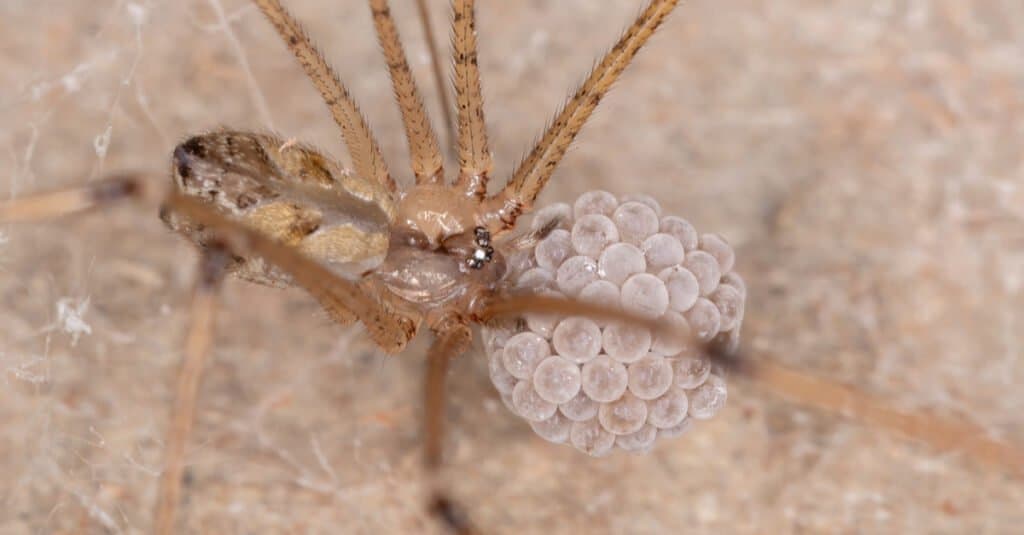
Long-bodied cellar spiders possess incredibly long legs that can measure nearly 2 inches (50 millimeters) long.
©iStock.com/ViniSouza128
Also known as the daddy long-legs spider, the long-bodied cellar spider is one of the most common spiders in Alaska. It also goes by the name the skull spider, due to the marking on its body that looks like a human skull.
Females normally measure 0.27 to 0.31 inches (7 to 8 millimeters long), while males measure around 0.23 (6 millimeters long). Meanwhile, an adult female’s legs can reach nearly 2 inches (50 millimeters) long, which is where they get their name. In appearance, they usually appear tan or yellow, with grey markings on the carapace.
You’ll most likely encounter long-bodied cellar spiders in cellars and other indoor areas, as they don’t tolerate the cold well. They prefer dark, quiet areas, and will usually run away if disturbed. They are not known to bite humans and are considered relatively harmless. When hunting, they will leave their webs to track down their prey, which includes other spiders.
#9: Black and Yellow Garden Spider
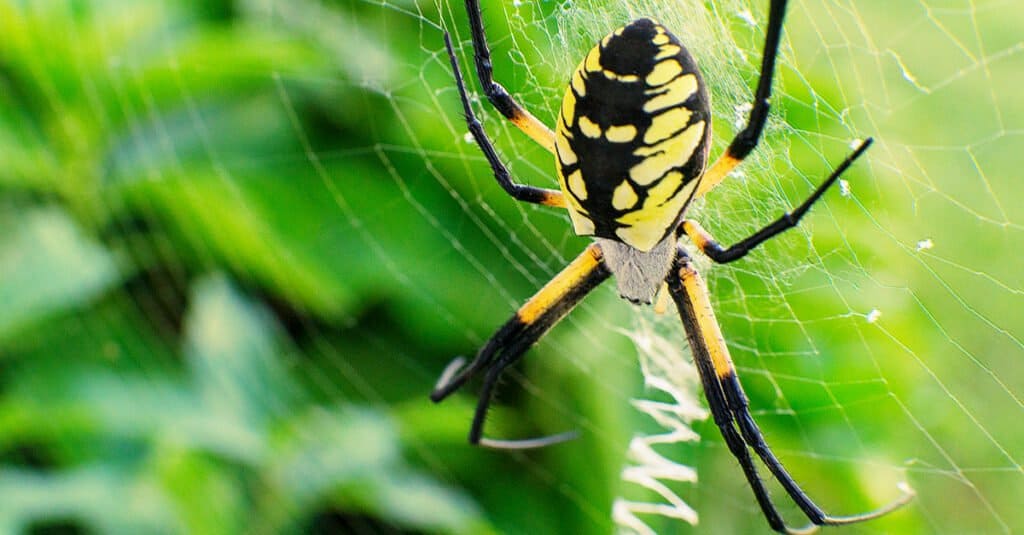
Black and
yellow garden spiders
get their name from their distinctive zigzag coloring.
©Theodore P. Webb/Shutterstock.com
The black and yellow garden spider is another one of the commonly sighted spiders in Alaska. It goes by many other names, including the golden garden spider, writing spider, zigzag spider, and corn spider. All these names refer to its distinctive yellow and black markings, which crisscross its abdomen.
Female black and yellow garden spiders typically measure between 0.7 to 1.1 inches (19 to 28 millimeters) long. Meanwhile, males normally range from 0.2 to 0.4 inches (5 to 9 millimeters) long. They build distinctive circular webs measuring around 2 feet wide (0.6 meters) made up of dense, zigzagging threads.
Black and yellow garden spiders are mostly solitary and tend to build their nests in fields or under the eaves of houses. They will bite when threatened, but their bite is not normally harmful to humans. Usually, the bite inflicts only mild pain and causes some localized swelling and redness.
#8: Cat-Faced Spider
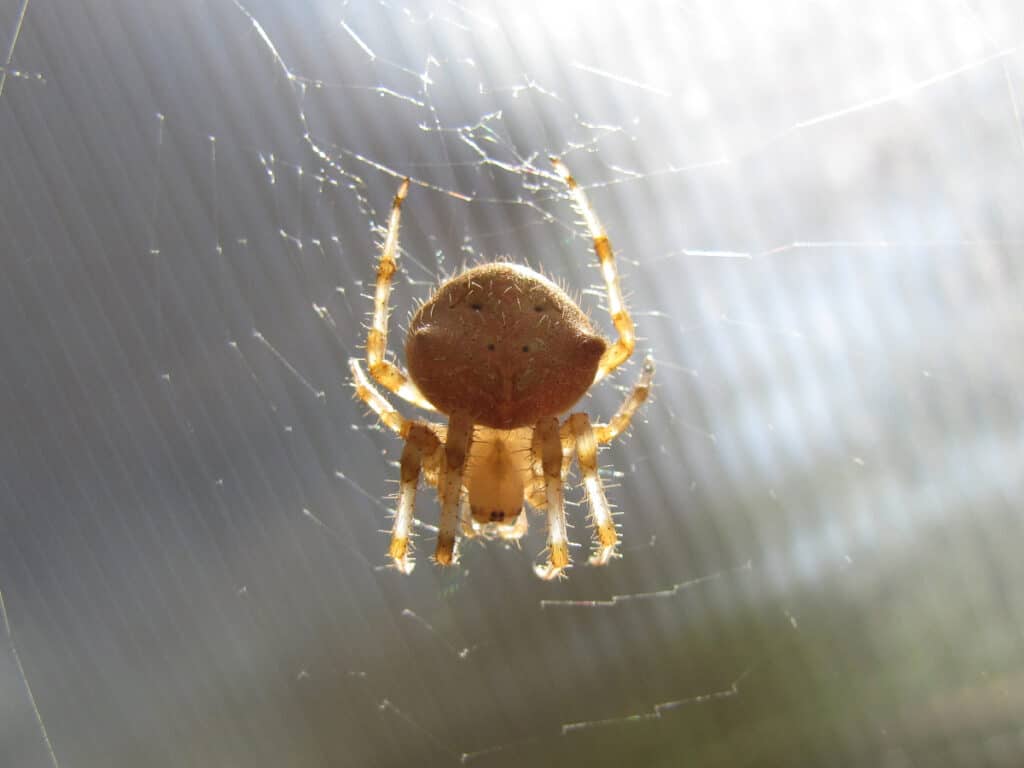
The cat-faced spider has an abdomen with large bumps that seem to look like the ears and face of a cat.
©iStock.com/TaosAnne
Also known as the jewel spider, the cat-faced spider is a member of the orb weaver family of spiders. It gets its name from the bumps on its abdomen which look like the ears and face of a cat.
Female cat-faced spiders measure around 0.5 to 0.9 inches (13 to 24 millimeters) long, while males measure much smaller at 0.2 to 0.3 inches (5 to 8 millimeters) long. While they range in color, they normally appear either pale yellow or dark brown. A single female will lay hundreds of eggs. Upon hatching, the young spiderlings will cannibalize each other until only a few remain.
You’ll often find cat-faced spiders hanging upside down in their webs while they wait for prey. They are natural predators of many insects and are therefore considered beneficial to humans. Additionally, their bite contains low levels of venom and is relatively harmless to humans.
#7: Northern Cupboard Spider
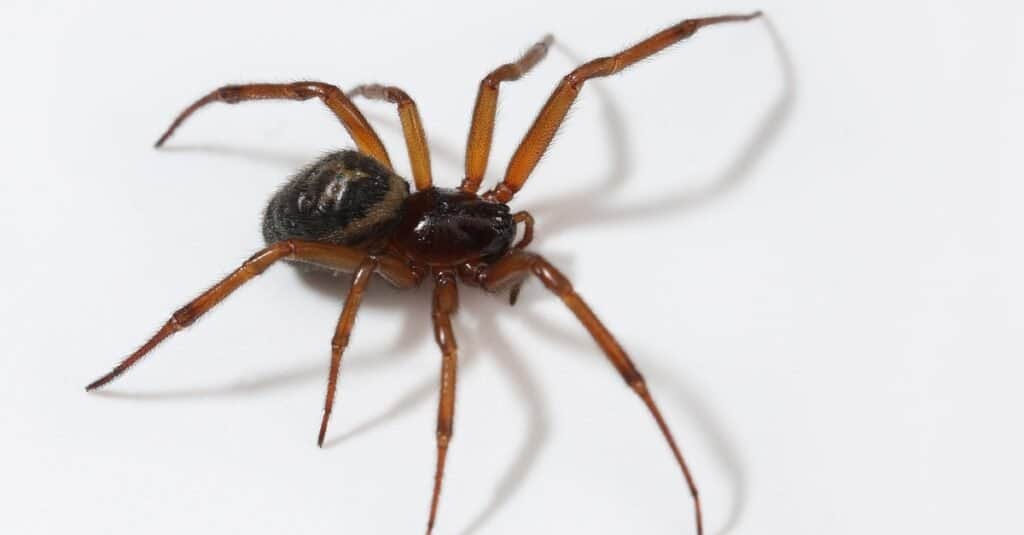
The northern cupboard spider is also known as a false widow due to its appearance to its venomous cousin.
©JASON STEEL/Shutterstock.com
Steatoda borealis, or the northern cupboard spider, is a member of the family Theridiidae, which includes around 120 species. You can find these spiders in Alaska, as well as the northern United States and Canada.
The average northern cupboard spider measures around 0.28 inches (7 millimeters) long, with males measuring smaller than females. They appear mostly dark brown or black with a glossy sheen and possess a T-shaped marking near the front of their bodies. Like other cobweb spiders, they construct irregular webs that they use to capture their prey. Due to their poor eyesight, they rely on sensing vibrations to detect when prey have entered their webs.
Cupboard spiders also go by the name false widows, due to their similar appearance to widow spiders. Unlike widows, their bite is relatively harmless and causes only mild pain, redness, and swelling.
#6: Furrow Spider
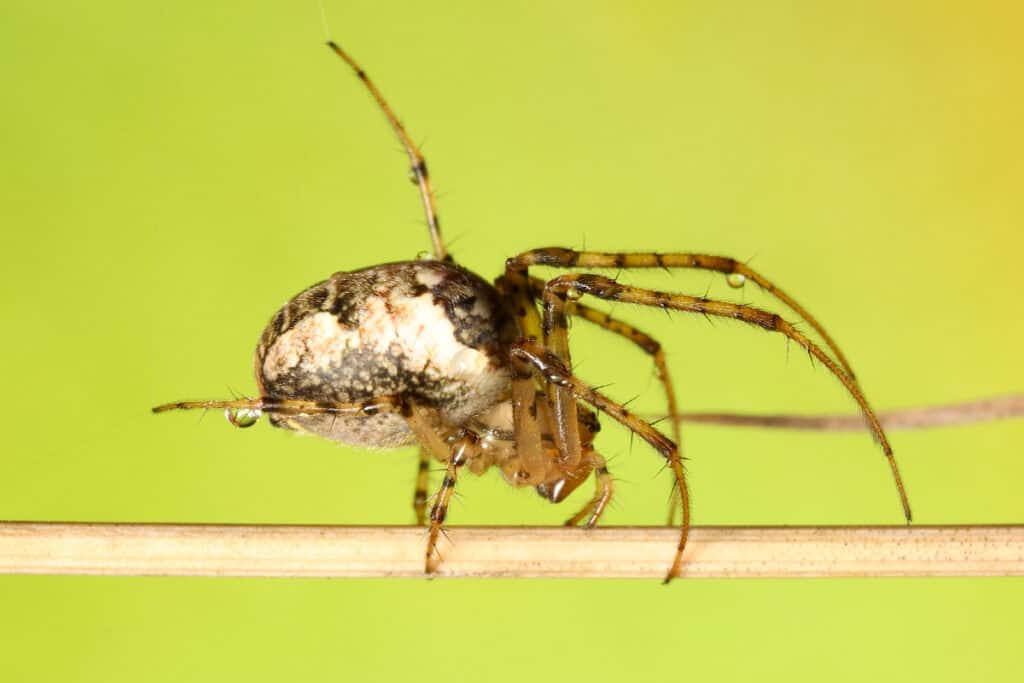
The furrow spider possesses intricate, foliate markings that look like arrows.
©iStock.com/Dan Olsen
Also known as the foliate spider due to its intricate markings, the furrow spider is another member of the orb weaver family. You can find these spiders in Alaska as well as many other northern regions including Europe, Asia, and Africa.
Female furrow spiders measure between 6 to 14 millimeters long, while males measure 5 to 9 millimeters. They range in color from black to grey to red and possess arrow-shaped markings on their abdomens. During the mating season, females create a silk cocoon in which the males will deposit their sperm inside before dying.
You’ll often find furrow spiders near water, as they prefer moist habitats. They are nocturnal and rely on their webs to help them catch prey. Although they are venomous, they produce such small amounts of toxin that their bite is of little risk to humans.
#5: Common Candy-Striped Spider

The common candy-striped spider has red stripes along its body that appear like candy stripes.
©iStock.com/Ines Carrara
The common candy-striped spider is a member of the cobweb spider family, Theridiidae. Originally from Europe, you can now find these spiders in Alaska as well as other parts of the United States and Canada. It gets its name from the red stripes which run down its abdomen, which look conspicuously like candy stripes.
Female common candy-striped spiders average around 0.24 inches (6 millimeters) long, with males measuring slightly smaller. Their bodies usually appear light green, cream, or white in color, while their legs are practically translucent.
Although they are small, common candy-striped spiders are vicious hunters capable of taking down insects much larger than themselves. They spin irregularly shaped webs made of tangled silk which they use to trap their prey. On rare occasions, they may bite humans, but their bite is relatively harmless and causes little more than some pain and swelling.
#4. Fierce Orb Weaver
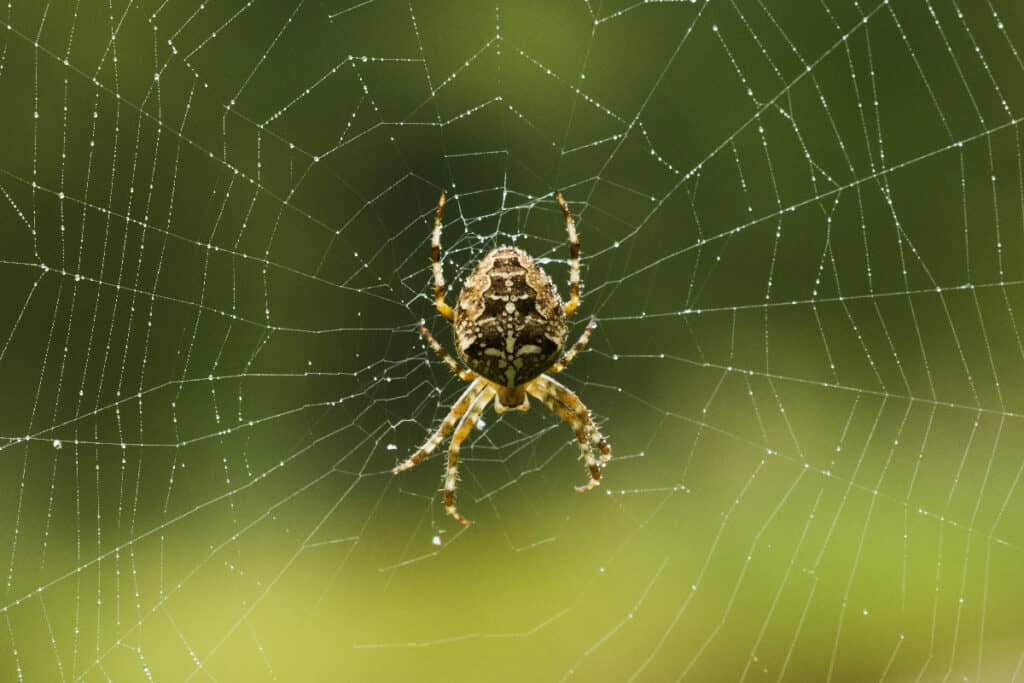
The fierce orb weaver rarely ever bites humans despite its fearsome name.
©iStock.com/mirceax
Araneus saevus, or the fierce orb weaver, belongs to the family Araneidae. You can find these spiders in Alaska as well as other parts of the United States, Europe, and even as far as Russia. Their preferred habitats include woodland areas and lawns with plenty of plant life to support their webs.
Female fierce orb weavers measure between 0.43 and 0.82 inches (11 and 21 millimeters) long, while males measure from 0.4 to 0.6 inches (9 to 14 millimeters) long. Most specimens appear dark brown or black, with males usually appearing darker than females. The species is identifiable by its dorsal humps and the stripe of white or cream that bisects the abdomen.
Fierce orb weavers rarely if ever bite humans. If you encounter one it is more likely to run away than to become aggressive. However, if you are bitten by a fierce orb weaver, the bite is likely to cause only mild pain, swelling, or nausea.
#3. Daring Jumping Spider

The daring
jumping spider
possesses excellent eyesight and leaping abilities, which it relies on to catch prey.
©Mircea Costina/Shutterstock.com
Also known as the bold jumper, the daring jumping spider is a member of the jumping spider family Salticidae. You can find these spiders in Alaska, as well as Canada, Mexico, and other parts of the United States.
Compared to most other jumping spiders, daring jumping spiders are quite large. On average, females measure around 11 millimeters long, while males measure around 8 millimeters. They generally appear black and sport an assortment of colorful blue, red, or yellow spots and stripes. Additionally, they possess bright metallic greenish-blue mouthparts, known as chelicerae.
Daring jumping spiders possess excellent eyesight, which aids them in their capture of prey. Upon sighting its target, a bold jumping spider will leap upon its prey and kill it with its venomous bite. While deadly to insects, its bite is rarely dangerous to humans. At worst, its bite causes some pain, redness, and swelling.
#2: Pacific Folding Door Spider
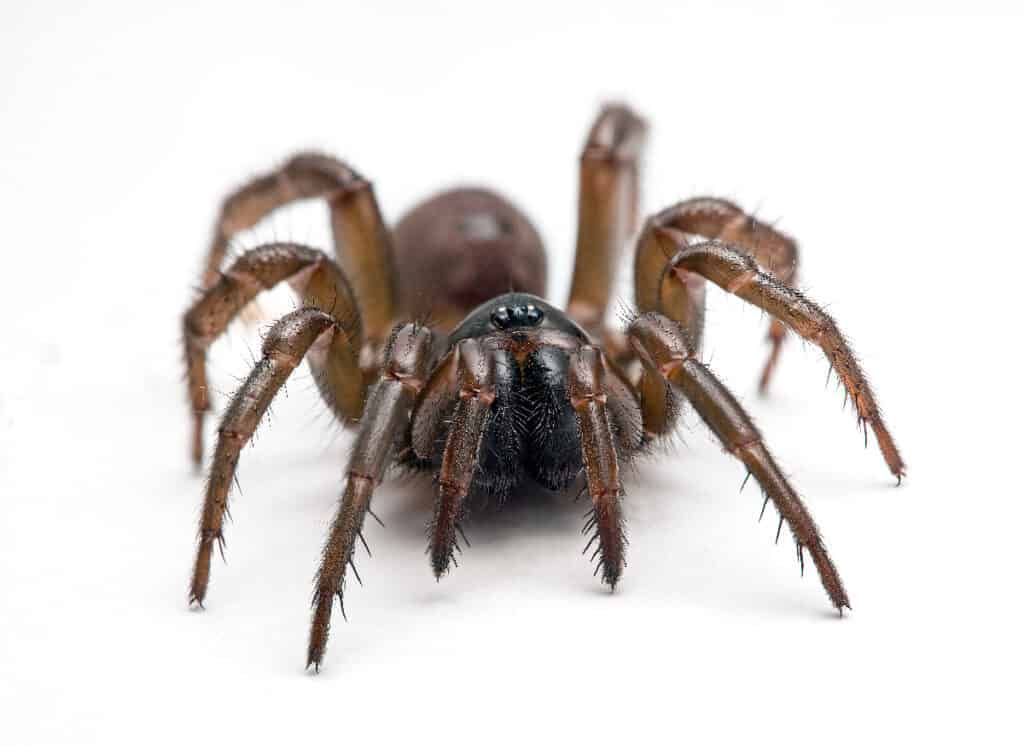
The Pacific folding door spider is the northernmost-dwelling trapdoor spider found in North America.
©Ernie Cooper/Shutterstock.com
The Pacific folding door spider gets its name both from its geographic distribution and habit of building burrows in the ground. It is found from Alaska in the north to California in the south, making it one of the most northerly distributed trapdoor spiders in North America.
Female Pacific folding door spiders typically measure around 0.5 inches (13 millimeters) long, while males measure about 0.43 inches (11 millimeters) long. Both sexes possess a dark brown or black carapace.
You’re most likely to encounter Pacific folding door spiders in cool, soft ground, which is where they prefer to build their burrows. They are nocturnal hunters and spend most of the day hidden away. At night, they wait near the entrance of their homes for unsuspecting prey to wander past. Beetles are their primary source of food, and they are unlikely to bite a person unless provoked.
#1. Shamrock Orb Weaver
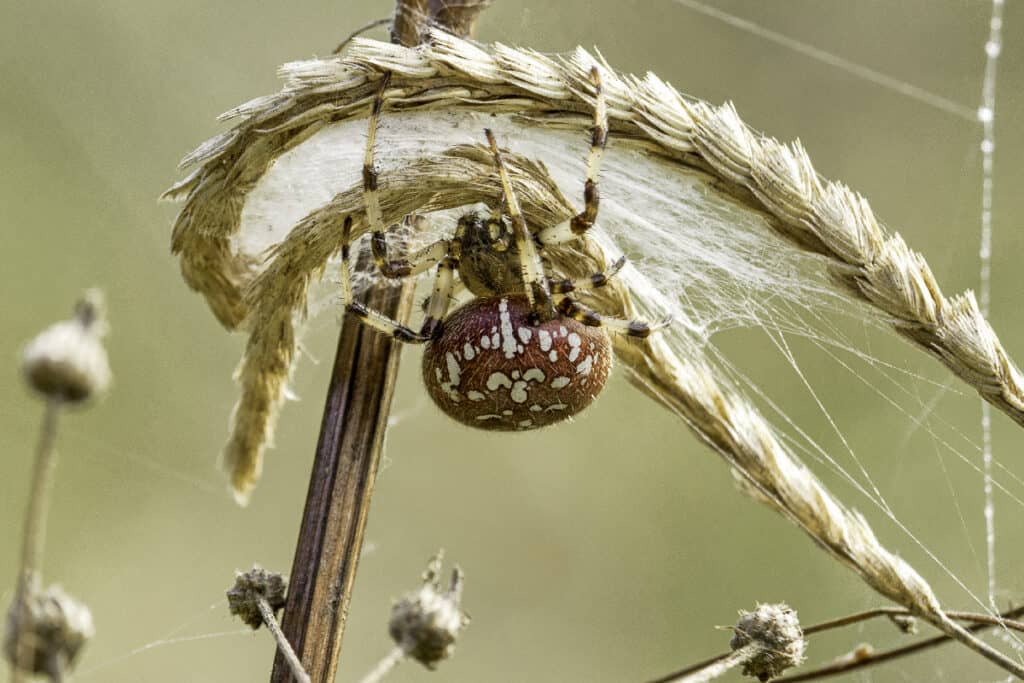
Shamrock orb weavers build webs that measure nearly 2 feet wide.
©iStock.com/StewartMyers
Shamrock orb weavers are common spiders in Alaska and parts of Canada and the northern United States. It’s a member of the orb weaver family Araneidae, and creates intricate webs like the rest of its family.
Most shamrock orb weavers have a beige or brown carapace, but they may contain a greenish or yellowish hue. It is further identifiable thanks to the several white dots that line their abdomens, and the three white bands that wrap around their legs.
Shamrock orb weavers catch prey inside their large webs, which can measure nearly 2 feet (0.6 meters) in diameter. While painful, the bite of a shamrock orb weaver is not dangerous to people. At worst, it is comparable to a mild bee sting.
Summary of 10 Spiders in Alaska
Here’s a recap of 10 spiders found in the state of Alaska that we took a look at:
| Number | Spider |
|---|---|
| 1 | Shamrock Orb Weaver |
| 2 | Pacific Folding Door Spider |
| 3 | Daring Jumping Spider |
| 4 | Fierce Orb Weaver |
| 5 | Common Candy-Striped Spider |
| 6 | Furrow Spider |
| 7 | Northern Cupboard Spider |
| 8 | Cat-Faced Spider |
| 9 | Black and Yellow Garden Spider |
| 10 | Long-Bodied Cellar Spider |
The photo featured at the top of this post is © by pap/Shutterstock.com
Thank you for reading! Have some feedback for us? Contact the AZ Animals editorial team.






